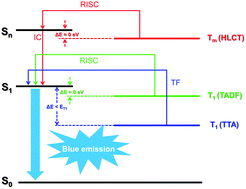Blue-emitting organic electrofluorescence materials: progress and prospective
Abstract
The intense interest in organic light-emitting devices (OLEDs) originates from their attractive prospects as the next generation display and lighting technologies. The development of blue emitters is of great significance in OLED applications as full-color displays and energy-saving lightings. The electrofluorescence using triplet energy for radiation has recently become a spotlight in the area of organic electronics. Various triplet-to-singlet conversion mechanisms have been established, including triplet–triplet annihilation (TTA), thermally activated delayed fluorescence (TADF) and “hot exciton” model with hybridized local and charge-transfer (HLCT) excited state, and they are expected to shed light on the development on blue OLEDs. This study revolves around the recent progress in blue electrofluorescence materials utilizing triplet excitons for radiation. Owing to the page limitation, special focus is placed on small molecule-based purely organic fluorophores with breakthrough device performances. We begin with the general information of blue-emitting organic electrofluorescence devices, and then give an overview of blue fluorescence OLEDs based on different electroluminescence mechanisms, which is followed by individual molecular design strategies towards high efficiency.


 Please wait while we load your content...
Please wait while we load your content...